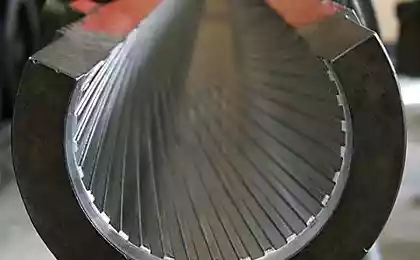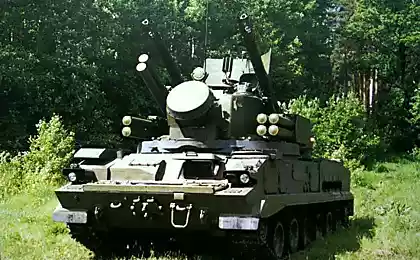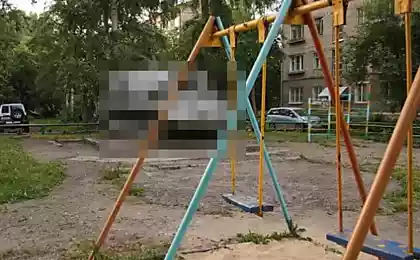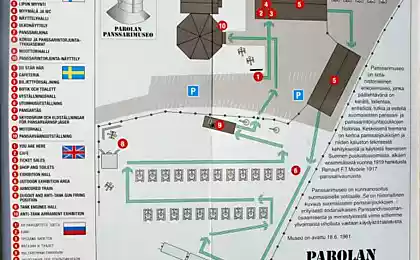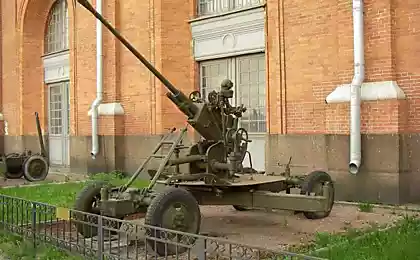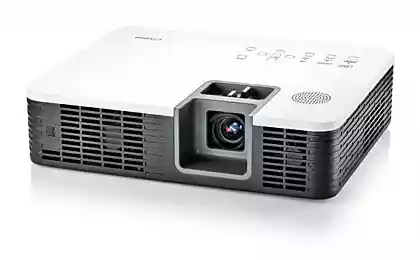585
ZSU-23-4 "Shilka"
"Shilka" was developed in the early 60s, and first shown publicly in 1965. The self-propelled unit was designed to address both air and ground targets. In large quantities, these settings are delivered to the Middle East. So, in 1973, Egypt has at its disposal 150 installations, and Syria - 100. During the first three days of the Egyptian-Israeli war "Shilka" shot down 30 Israeli planes. It was quite convincing proof reliability anti-aircraft, which provided her long years of service in many armies of the world. The Americans managed to grab a few plants, and conducting the study, they had to admit that "Shilka" is a very effective means to combat helicopters. While on the other hand, it has been noted shortcomings in the cooling system of barrels, and it was assumed that airborne electronic warfare system will be able to disable the radar installation.
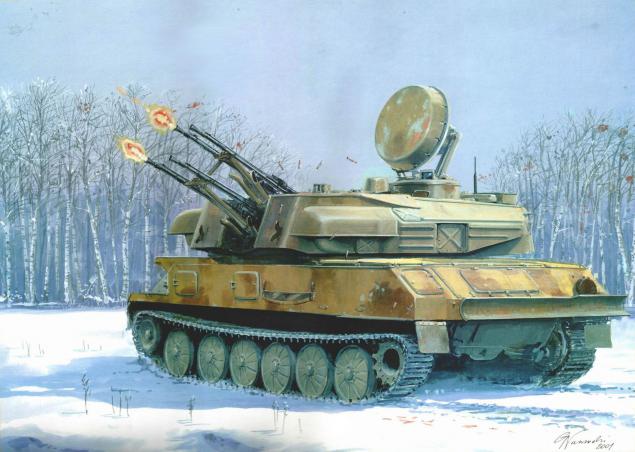
ZSU-23-4 "Shilka" is armed with four guns synchronized ARQ-23 caliber 23 mm. Guns are placed in a rotating turret and provide a field of fire of 360 degrees horizontally and vertically - from -4 to 85 degrees. Rate is 3600 rds. / Min. Ammunition is 2000 shells of two types: to combat air targets used combined shells - fragmentation, incendiary, and for shooting at ground targets armor-piercing incendiary. The firing range is 2500 m, ceiling - 1600 m. Fire control can be performed manually or automatically on the radar. The range of the radar is 30 km away. Firing can be performed with the place and on the fly at speeds up to 25 km / h.
In 1977, we developed a new modification of the installation, features a new radar system, cooling and ventilation of the machine guns. In 1990, Ukraine tower was installed on the chassis of the T-80UD, and in addition to the guns were mounted missile launchers "Igla". In fact, we got a set of "Chapparel-volcano" in one bottle. This hybrid was named "Donets". In 2000, again in the Ukraine it was attempted another modification "Shilka" - radar is supposed to replace the optoelectronic detection system goals set a new engine and a power supply system to reduce the crew to three people, and replace the "needle" on the rocket "Thunder" or some -nibud western analogue.
Analyzing the results of the 1973 war in the Middle East, foreign military observers noted that the first three days of fighting Syrian missile troops killed about 100 Israeli aircraft. In their view, this was due to the fact that heavy fire automatic ZSU-23-4 Soviet-era forced the Israeli pilots to escape from low altitudes where exactly was the area of action anti-aircraft missiles.
The appearance in the 50s anti-aircraft missiles, capable of hitting air targets at medium and high altitudes, has meant that pilots attack and bomber aircraft have mastered a new tactic - Sunset on terrestrial objects with small, up to 300 m, and extremely low altitudes . Hit-speed aircraft, the attacker for 15-30 seconds, the calculations and barreled anti-aircraft missile systems could not keep up. It took a new technology - mobile, high-speed, high degree of automation, able to fire up and on the go. Over such flak began to work and Soviet designers, who immediately faced with some serious problems, since before anything similar is not engaged.
First of all, it concerned the layout. Relatively light but bulky electronics at first supposed to be placed inside the body self-propelled guns, but for various reasons, especially because of the length of the waveguide radar, this option was rejected. Then they decided to mount weapons, equipment and place in a large crew, the tower closed. However, the tactical and technical requirements allows you to restrict semi-closed car, but the roof is needed to protect against moisture and dust radio electronics.
Composed while armed with 37- and 57-mm gun was not satisfied with the designers of the cassette mechanism charged (hence the low rate of fire) and large mass, demanding powerful actuators. Another thing is -23 mm automatic gun with a belt nutrition, which, incidentally, allowed to do without charging. A relatively small power of its fragmentation projectile completely offset by significant weight second volley - this method has long been used in fighter aircraft.
I brought a lot of trouble for the choice of the radar antenna. After all, when installing the barrel before firing to pre-empt a mismatch between the line of the shot and the electrical axis of the radar, which is why they are the trunks, may be a hindrance for the radio beam. At first we thought the cannon set in pairs on the sides of the tower and the antenna and optical sight ahead. However, the diversity artillery systems would increase the moment of inertia of a rotating turret, and a failure would create asymmetric load on the drive. In addition, the antenna reflector would overlap with the gunner monitor the front hemisphere. Therefore, place the trunks singled to center setting and put the antenna in front and to the side of them. However, the shots on the range muzzle blast destroyed her ...
The final version of the antenna mounted on the stern, high-bracket (stowed her mirror laid on the roof of the power pack) and trunks - come in two tiers, which are installed between the boxes with ammunition.
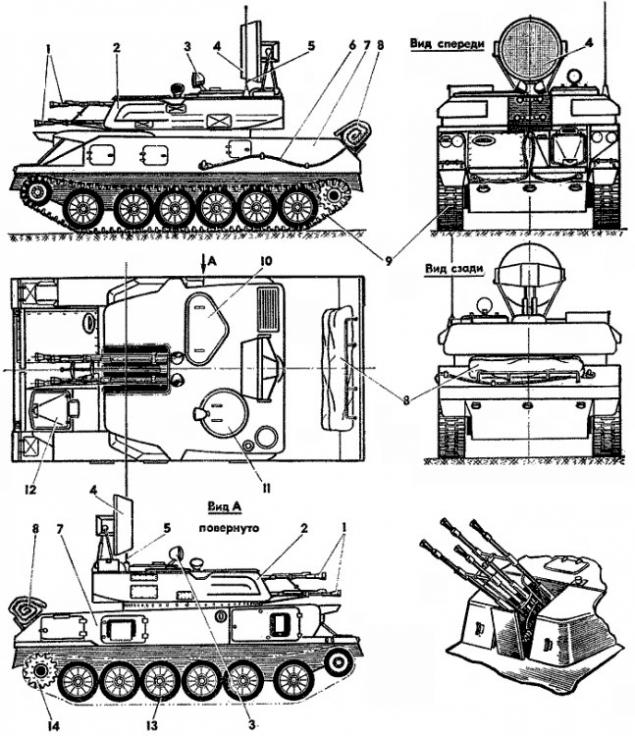
Made in the tower ran in running pilot carried out on the basis of the Su-85, to be used as the chassis for the cars of the future, removing the gun and reduce full-time reservation. It was possible to save 4 tons, but the mass of fully equipped towers topped 8 tons! More appropriate PT-76, but needed a thorough reworking of the body to establish a hard and complicated shoulder straps with a diameter of 2700 mm under the tower. It's better to create a special body. So they did - the tower kept on chasing the T-54, is lowered below the upper edge of the boards, and is based on a light box-like frame that provides strength tonkobronnomu body. Her lower cylindrical portion which is ideally located in nadgusenichnyh niches.
The overall layout was a classic - in front of the separation of management, followed by fighting in the stern engine-transmission. To increase the specific power of the engine in the forced-6P used ejection cooling system. It consumes only 2, 2-2, 5% of its power (compared to 10-12% for the fan). Air intake for the engine equipped with the labyrinthine system of walls, where large dust particles get stuck, then air is passed through a tunnel along the side and enters the main filter with ejection suction remnants of dust exhaust. The torque from the engine is transmitted to the drive wheels via the guitar, the main clutch, five-speed synchromesh gearbox, planetary rotation mechanisms and airborne transmission. Chassis with six-row bearing rollers on board borrowed from the PT-76, provide smooth motion torsion bar suspension with big strokes and powerful shock absorbers at the first, fifth and sixth left-right sites. The life of a caterpillar raised, sealed with rubber sleeves ends hinges on the moving parts that do not fall abrasive particles. Fuel was in internal tanks - one in the power department, the other - the right of the driver.
At the march on a good road power station operated by the main engine, on heavy soils and fixed positions are automatically switched turbine DT-4 capacity of 80 liters. s., which, though absorbed a lot of fuel, but a minute later gave the load after switching on. Equal tanks mobility and terrain combat vehicle allowed to cover the troops on the march - the fire was effective thanks to the stabilization of the line of sight and shot.
Radar complex provides automatic search, detection and destruction of air targets at altitudes of 100-1500 m. When operating in combined mode, when the range is set locator and angular coordinates - optical viewfinder, shooting is conducted on aircraft flying at ultra low. If they put the noise or lobbing rockets, homing on radar radiation, the station is switched off and the gunner carries aiming for Scooter.
After extensive testing self-propelled anti-aircraft weapon ZSU-23-4 "Shilka" was put into service. In the manufacturing process it upgraded several times. In particular, the system has undergone significant changes vozduhopitaniya radiopribornogo complex. As for cooling (and therefore for reliable operation) require a constant supply of high-purity air in front of the air intake housing installed with an effective cleaning system. At the same time strengthened the performance of the ventilation of the fighting compartment.
The possibility of replacing the quad 23 mm installation 30mm sshesterennoy gun with a rotating barrel unit, which would dramatically increase the density of fire. However, the artillery system, designed for fleet proved too fastidious for ground conditions.
In addition, comparative tests of various anti-aircraft guns have shown that even with the standard weapons "Shilka" is not inferior to a battery of four 57 mm guns of C-60, which includes 12 pieces of equipment with the expectation of 57 soldiers and officers.
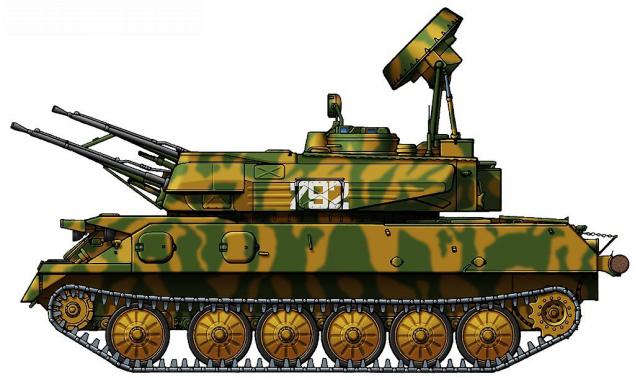
Source:

ZSU-23-4 "Shilka" is armed with four guns synchronized ARQ-23 caliber 23 mm. Guns are placed in a rotating turret and provide a field of fire of 360 degrees horizontally and vertically - from -4 to 85 degrees. Rate is 3600 rds. / Min. Ammunition is 2000 shells of two types: to combat air targets used combined shells - fragmentation, incendiary, and for shooting at ground targets armor-piercing incendiary. The firing range is 2500 m, ceiling - 1600 m. Fire control can be performed manually or automatically on the radar. The range of the radar is 30 km away. Firing can be performed with the place and on the fly at speeds up to 25 km / h.
In 1977, we developed a new modification of the installation, features a new radar system, cooling and ventilation of the machine guns. In 1990, Ukraine tower was installed on the chassis of the T-80UD, and in addition to the guns were mounted missile launchers "Igla". In fact, we got a set of "Chapparel-volcano" in one bottle. This hybrid was named "Donets". In 2000, again in the Ukraine it was attempted another modification "Shilka" - radar is supposed to replace the optoelectronic detection system goals set a new engine and a power supply system to reduce the crew to three people, and replace the "needle" on the rocket "Thunder" or some -nibud western analogue.
Analyzing the results of the 1973 war in the Middle East, foreign military observers noted that the first three days of fighting Syrian missile troops killed about 100 Israeli aircraft. In their view, this was due to the fact that heavy fire automatic ZSU-23-4 Soviet-era forced the Israeli pilots to escape from low altitudes where exactly was the area of action anti-aircraft missiles.
The appearance in the 50s anti-aircraft missiles, capable of hitting air targets at medium and high altitudes, has meant that pilots attack and bomber aircraft have mastered a new tactic - Sunset on terrestrial objects with small, up to 300 m, and extremely low altitudes . Hit-speed aircraft, the attacker for 15-30 seconds, the calculations and barreled anti-aircraft missile systems could not keep up. It took a new technology - mobile, high-speed, high degree of automation, able to fire up and on the go. Over such flak began to work and Soviet designers, who immediately faced with some serious problems, since before anything similar is not engaged.
First of all, it concerned the layout. Relatively light but bulky electronics at first supposed to be placed inside the body self-propelled guns, but for various reasons, especially because of the length of the waveguide radar, this option was rejected. Then they decided to mount weapons, equipment and place in a large crew, the tower closed. However, the tactical and technical requirements allows you to restrict semi-closed car, but the roof is needed to protect against moisture and dust radio electronics.
Composed while armed with 37- and 57-mm gun was not satisfied with the designers of the cassette mechanism charged (hence the low rate of fire) and large mass, demanding powerful actuators. Another thing is -23 mm automatic gun with a belt nutrition, which, incidentally, allowed to do without charging. A relatively small power of its fragmentation projectile completely offset by significant weight second volley - this method has long been used in fighter aircraft.
I brought a lot of trouble for the choice of the radar antenna. After all, when installing the barrel before firing to pre-empt a mismatch between the line of the shot and the electrical axis of the radar, which is why they are the trunks, may be a hindrance for the radio beam. At first we thought the cannon set in pairs on the sides of the tower and the antenna and optical sight ahead. However, the diversity artillery systems would increase the moment of inertia of a rotating turret, and a failure would create asymmetric load on the drive. In addition, the antenna reflector would overlap with the gunner monitor the front hemisphere. Therefore, place the trunks singled to center setting and put the antenna in front and to the side of them. However, the shots on the range muzzle blast destroyed her ...
The final version of the antenna mounted on the stern, high-bracket (stowed her mirror laid on the roof of the power pack) and trunks - come in two tiers, which are installed between the boxes with ammunition.

Made in the tower ran in running pilot carried out on the basis of the Su-85, to be used as the chassis for the cars of the future, removing the gun and reduce full-time reservation. It was possible to save 4 tons, but the mass of fully equipped towers topped 8 tons! More appropriate PT-76, but needed a thorough reworking of the body to establish a hard and complicated shoulder straps with a diameter of 2700 mm under the tower. It's better to create a special body. So they did - the tower kept on chasing the T-54, is lowered below the upper edge of the boards, and is based on a light box-like frame that provides strength tonkobronnomu body. Her lower cylindrical portion which is ideally located in nadgusenichnyh niches.
The overall layout was a classic - in front of the separation of management, followed by fighting in the stern engine-transmission. To increase the specific power of the engine in the forced-6P used ejection cooling system. It consumes only 2, 2-2, 5% of its power (compared to 10-12% for the fan). Air intake for the engine equipped with the labyrinthine system of walls, where large dust particles get stuck, then air is passed through a tunnel along the side and enters the main filter with ejection suction remnants of dust exhaust. The torque from the engine is transmitted to the drive wheels via the guitar, the main clutch, five-speed synchromesh gearbox, planetary rotation mechanisms and airborne transmission. Chassis with six-row bearing rollers on board borrowed from the PT-76, provide smooth motion torsion bar suspension with big strokes and powerful shock absorbers at the first, fifth and sixth left-right sites. The life of a caterpillar raised, sealed with rubber sleeves ends hinges on the moving parts that do not fall abrasive particles. Fuel was in internal tanks - one in the power department, the other - the right of the driver.
At the march on a good road power station operated by the main engine, on heavy soils and fixed positions are automatically switched turbine DT-4 capacity of 80 liters. s., which, though absorbed a lot of fuel, but a minute later gave the load after switching on. Equal tanks mobility and terrain combat vehicle allowed to cover the troops on the march - the fire was effective thanks to the stabilization of the line of sight and shot.
Radar complex provides automatic search, detection and destruction of air targets at altitudes of 100-1500 m. When operating in combined mode, when the range is set locator and angular coordinates - optical viewfinder, shooting is conducted on aircraft flying at ultra low. If they put the noise or lobbing rockets, homing on radar radiation, the station is switched off and the gunner carries aiming for Scooter.
After extensive testing self-propelled anti-aircraft weapon ZSU-23-4 "Shilka" was put into service. In the manufacturing process it upgraded several times. In particular, the system has undergone significant changes vozduhopitaniya radiopribornogo complex. As for cooling (and therefore for reliable operation) require a constant supply of high-purity air in front of the air intake housing installed with an effective cleaning system. At the same time strengthened the performance of the ventilation of the fighting compartment.
The possibility of replacing the quad 23 mm installation 30mm sshesterennoy gun with a rotating barrel unit, which would dramatically increase the density of fire. However, the artillery system, designed for fleet proved too fastidious for ground conditions.
In addition, comparative tests of various anti-aircraft guns have shown that even with the standard weapons "Shilka" is not inferior to a battery of four 57 mm guns of C-60, which includes 12 pieces of equipment with the expectation of 57 soldiers and officers.

Source:











